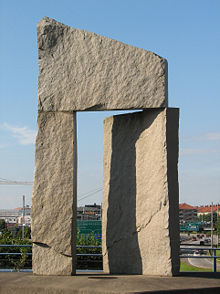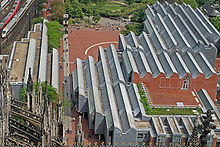Bohus (granite)

Bohus is a Swedish granite that was mainly quarried in numerous quarries in the Bohuslän area in western Sweden, formerly especially on the banks of the Iddefjord and Gullmarsfjord . Today some quarries are still in operation. This granite was formed in the Precambrian 920 million years ago.
Names
The name of this granite comes from the Swedish town of Bohus , which has merged with the town of Surte .
In the stonemasonry , the red type of granules is called Bohus and the gray type is called Bohus Tossene (after quarry), but is usually simplified after the color Bohus Red or Bohus Gray .
Other names for the red type are Bohus Röd ; further to quarries or to places Bohus Röd Bretteby , Bohus Röd Skarstad , Bohus Nordgard , Bohus Hallinden or Bohus Bovallstrand .
Geology and occurrence
Bohus did not arise in a large pluton , but silica-containing magma penetrated into crevices and weak zones of the Baltic Shield , solidified next to metamorphic rocks in crevices and corridors that were a few decimeters to about 100 meters wide.
The occurrence of the Stora Le-Marstrand Formation extends from Lysekil to Strömstad . Investigations have shown that "the Bohus granite bodies in the Skagerrak continue at least 80 km to the west and are probably up to 4 km thick ".
The quarries are located in coastal areas, especially around Bovallstrand and Hunnebostrand , but also further away. Large mining centers were located in the vicinity of Krokstrand and Näsinge , on Malmön and near Brastad .
Rock description
Bohus is characterized by strong red potassium feldspars and gray to gray- greenish plagioclases . The granular structure of this natural stone was created by biotite and Bohus also contains gray quartz .
Depending on the location and quarry, Bohus differs greatly in color, the grain size of the minerals or in the texture , the distribution of the minerals. There are Bohus types that are not red or reddish, but gray or reddish brown, or, depending on their occurrence, fine, medium or coarse-grained. At Lysekil , for example, there is a fine-grain Bohus type whose occurrence is criss-crossed by pegmatites .
Bohus is only quarried in a few quarries, such as the Broberg quarry .
use
Bohus was used in prehistory for stone setting and on Bohus rocks there are prehistoric mythological engravings.
Bohus is used in solid construction and construction for stair and floor coverings, for window sills and facade panels, in road and horticulture, in sculpture and for tombs. In Sweden and Norway it was also used in hydraulic engineering and as a paving stone .
In Sweden, the foreign demand for this granite created a large stone industry from around 1875 and global trade, with Germany being one of the largest trading partners. In northern Germany near the coast, due to the lack of usable rock deposits, Bohus was often used in road construction and horticulture as paving stone and as a curb , and also in cemeteries. In the area of the Bohus deposit, the stonemasonry is still to be found in the towns of Strömstad , Sotenäs and Tanum .
Bohus is one of the hard stones and is frost-resistant and can be polished.
In Germany, the Rathausmarkt Hamburg as well as other pedestrian zones in northern Germany and the forecourt of the Museum Ludwig in Cologne have been paved with Bohus. Imports in Germany have fallen sharply, as there is an extensive international range of red natural stones .
Others
The Stenhuggar Museum is located in the Hunnebostrand quarry and shows old techniques, mining methods and the granite processing of this natural stone .
Photo gallery
Bronze sculpture by Evert Taube on a base from Bohus in Grebbestad
See also
literature
- Friedrich Müller: INSK compact. The international natural stone index for the current market . Ebner Verlag, Ulm 1977, sheet 1.3, Bohus Röd
Web links
- bohusgranit.se : Bohus Granit AB (Swedish)
- utgangpunkten.se : Illustration of lions from Bohus (around 1900) (Swedish)
Individual evidence
- ↑ In other sources 890 million years ago
- ↑ a b c strand-steinde.de : West Sweden - Bohuslän , accessed on May 7, 2011
- ↑ strand-und-steine.de : West Sweden - Stora Le-Marstrand Formation , accessed on May 7, 2011
- ↑ Friedrich Müller: Sheet 1.3 (see literature)
- ↑ emmabodagranit.se : Stone from Broberg, in English, accessed on May 15, 2011
Coordinates: 58 ° 24 ′ 50.7 " N , 11 ° 29 ′ 40.3" E








